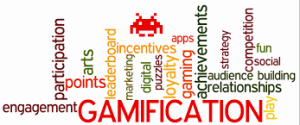With such a stress and emphasis put on marketing with the right strategies and reaching the right audiences, over complication can be at the forefront of business digital marketing techniques these days, and what do people enjoy the most? well, having fun of course. this is where Gamification comes into play, put simply, it is where you acquire something pre existing and implement game mechanics into it, increasing participating customers experience, driving engagement and furthermore inflating customer loyalty through boosted competition, point scoring or an opportunity to win (Conaway, 2014).
Disregarded by some, the idea of gamification and its benefits to a digital marketing campaign have been explored by Lucassen et al (2014) . the idea is that essentially gamification acts as a benefactor to the marketing mix, driving basic elements of awareness, engagement and loyalty. Its an exciting era to ditching the traditional campaign model and introducing innovative movement.
Awareness:
This idea can be argued to be the most important, the use of converting your marketing strategy into a gamified process, increases word of mouth about the product therefore creating more brand awareness. This can be exemplified by the way in which Dominoes incorporated gamification into their mobile pizza ordering process, mirroring the idea of roulette, where users can shake their smart phone or android and the app will pick the toppings at random.
Engagement:
Competition is embedded in our very own human nature, and what better way to engage a consumer than to touch on their competitive side? Point scoring, leader boards, prize draws and lucky dips all engage a consumer on a deeper emotional level than a traditional marketing campaign, highlighted by Lucassen (2014) who found that with an increased competitive edge, consumers are engaged by up to 68% more. A good example of this consumer engagement is McDonalds monopoly prize draw, where customers rip tickets off meals and collect them to win prizes.
Loyalty:
Interlinked with engagement, Lucassen (2014) found that with a higher commitment on an emotional level that customer loyalty will increase. The company POPchips executed this well by temaing up with a mobile game company that when certain levels of points were scored on the game, prize draws were given out, a basic premise that is very effective in keeping the same customers returning.
Just to emphasise the importance of this Gartner Inc (2011) argues that by 2015 50% or more companies that managed innovative marketing processes gamified those procedures, and that by the year 2014 these very movements became as important as the likes of Facebook, eBay or amazon.
Gartner identified four main principles for gamification:
1. Accelerated feedback cycles. In the real world, feedback loops are slow (e.g., annual performance appraisals) with long periods between milestones. Gamification increases the velocity of feedback loops to maintain engagement.
2. Clear goals and rules of play. In the real world, where goals are fuzzy and rules selectively applied, gamification provides clear goals and well-defined rules of play to ensure players feel empowered to achieve goals.
3. A compelling narrative. While real-world activities are rarely compelling, gamification builds a narrative that engages players to participate and achieve the goals of the activity.
4. Tasks that are challenging but achievable. While there is no shortage of challenges in the real world, they tend to be large and long-term. Gamification provides many short-term, achievable goals to maintain engagement.
(source: Gartner)
The innovative capacity of gamification process in the marketing mix stands companies at a competitive edge, but many cases show that it needs to be used correctly or else a fail could be on the cards!
References:
Conaway, R. (2014). Gamification and service marketing. Springerplus. 3 (1), p358-387.
Lucassen, G. (2014). Gamification in Consumer Marketing – Future or Fallacy? .Procedia – Social and Behvioral Sciences. 148 (1), p194-202.





